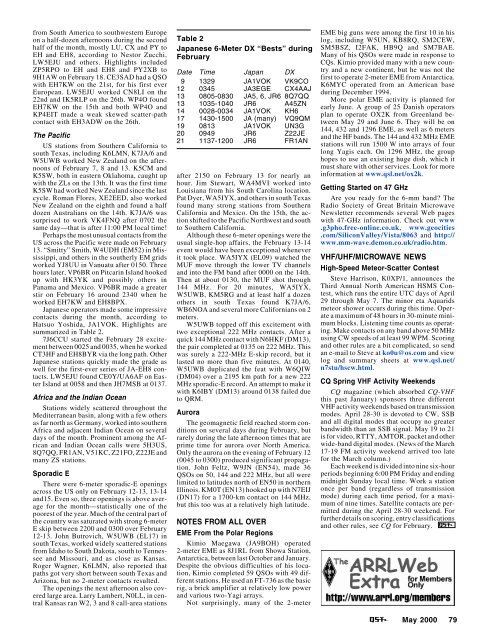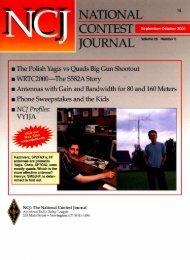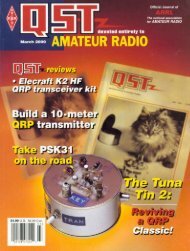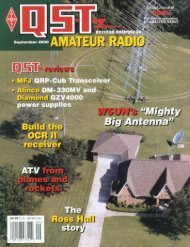You also want an ePaper? Increase the reach of your titles
YUMPU automatically turns print PDFs into web optimized ePapers that Google loves.
from South America to southwestern Europeon a half-dozen afternoons during the secondhalf of the month, mostly LU, CX and PY toEH and EH8, according to Nestor Zucchi,LW5EJU and others. Highlights includedZP5RPO to EH and EH8 and PY2XB to9H1AW on February 18. CE3SAD had a QSOwith EH7KW on the 21st, for his first everEuropean. LW5EJU worked CN8LI on the22nd and IK5RLP on the 26th. WP4O foundEH7KW on the 15th and both WP4O andKP4EIT made a weak skewed scatter-pathcontact with EH3ADW on the 26th.The PacificUS stations from Southern California tosouth Texas, including K6LMN, K7JA/6 andW5UWB worked New Zealand on the afternoonsof February 7, 8 and 13. K5CM andK5SW, both in eastern Oklahoma, caught upwith the ZLs on the 13th. It was the first timeK5SW had worked New Zealand since the lastcycle. Roman Flores, XE2EED, also workedNew Zealand on the eighth and found a halfdozen Australians on the 14th. K7JA/6 wassurprised to work VK4FNQ after 0702 thesame day—that is after 11:00 PM local time!Perhaps the most unusual contacts from theUS across the Pacific were made on February13. “Smitty” Smith, W4UDH (EM52) in Mississippi,and others in the southerly EM gridsworked YJ8UU in Vanuatu after 0150. Threehours later, VP6BR on Pitcarin Island hookedup with HK3YK and possibly others inPanama and Mexico. VP6BR made a greaterstir on February 16 around 2340 when heworked EH7KW and EH8BPX.Japanese operators made some impressivecontacts during the month, according toHatsuo Yoshida, JA1VOK. Highlights aresummarized in Table 2.7J6CCU started the February 28 excitementbetween 0025 and 0035, when he workedCT3HF and EH8BYR via the long path. OtherJapanese stations quickly made the grade aswell for the first-ever series of JA-EH8 contacts.LW5EJU found CE0Y/UA6AF on EasterIsland at 0058 and then JH7MSB at 0137.Africa and the Indian OceanStations widely scattered throughout theMediterranean basin, along with a few othersas far north as Germany, worked into southernAfrica and adjacent Indian Ocean on severaldays of the month. Prominent among the Africanand Indian Ocean calls were 5H3US,8Q7QQ, FR1AN, V51KC, Z21FO, Z22JE andmany ZS stations.Sporadic EThere were 6-meter sporadic-E openingsacross the US only on February 12-13, 13-14and15. Even so, three openings is above averagefor the month—statistically one of thepoorest of the year. Much of the central part ofthe country was saturated with strong 6-meterE skip between 2200 and 0300 over February12-13. John Butrovich, W5UWB (EL17) insouth Texas, worked widely scattered stationsfrom Idaho to South Dakota, south to Tennesseeand Missouri, and as close as Kansas.Roger Wagner, K6LMN, also reported thatpaths got very short between south Texas andArizona, but no 2-meter contacts resulted.The openings the next afternoon also coveredlarge area. Larry Lambert, N0LL, in centralKansas ran W2, 3 and 8 call-area stationsTable 2Japanese 6-Meter DX “Bests” duringFebruaryDate Time Japan DX9 1329 JA1VOK VK9CO12 0345 JA3EGE CX4AAJ13 0805-0830 JA5, 6, JR6 8Q7QQ13 1035-1040 JR6 A45ZN14 0028-0034 JA1VOK KH617 1430-1500 JA (many) VQ9QM19 0813 JA1VOK UN3G20 0949 JR6 Z22JE21 1137-1200 JR6 FR1ANafter 2150 on February 13 for nearly anhour. Jim Stewart, WA4MVI worked intoLouisiana from his South Carolina location.Pat Dyer, WA5IYX, and others in south Texasfound many strong stations from SouthernCalifornia and Mexico. On the 15th, the actionshifted to the Pacific Northwest and southto Southern California.Although these 6-meter openings were theusual single-hop affairs, the February 13-14event would have been exceptional wheneverit took place. WA5IYX (EL09) watched theMUF move through the lower TV channelsand into the FM band after 0000 on the 14th.Then at about 0130, the MUF shot through144 MHz. For 20 minutes, WA5IYX,W5UWB, KM5RG and at least half a dozenothers in south Texas found K7JA/6,WB6NOA and several more Californians on 2meters.W5UWB topped off this excitement withtwo exceptional 222 MHz contacts. After aquick 144 MHz contact with N6HKF (DM13),the pair completed at 0135 on 222 MHz. Thiswas surely a 222-MHz E-skip record, but itlasted no more than five minutes. At 0140,W5UWB duplicated the feat with W6QIW(DM04) over a 2195 km path for a new 222MHz sporadic-E record. An attempt to make itwith K6IBY (DM13) around 0138 failed dueto QRM.AuroraThe geomagnetic field reached storm conditionson several days during February, butrarely during the late afternoon times that areprime time for aurora over North America.Only the aurora on the evening of February 12(0045 to 0300) produced significant propagation.John Feltz, W9JN (EN54), made 36QSOs on 50, 144 and 222 MHz, but all werelimited to latitudes north of EN50 in northernIllinois. KM0T (EN13) hooked up with N7EIJ(DN17) for a 1700-km contact on 144 MHz,but this too was at a relatively high latitude.NOTES FROM ALL OVEREME From the Polar RegionsKimio Maegawa (JA9BOH) operated2-meter EME as 8J1RL from Showa Station,Antarctica, between last October and January.Despite the obvious difficulties of his location,Kimio completed 59 QSOs with 49 differentstations. He used an FT-736 as the basicrig, a brick amplifier at relatively low powerand various two-Yagi arrays.Not surprisingly, many of the 2-meterEME big guns were among the first 10 in hislog, including W5UN, KB8RQ, SM2CEW,SM5BSZ, I2FAK, HB9Q and SM7BAE.Many of his QSOs were made in response toCQs. Kimio provided many with a new countryand a new continent, but he was not thefirst to operate 2-meter EME from Antarctica.K6MYC operated from an American baseduring December 1994.More polar EME activity is planned forearly June. A group of 25 Danish operatorsplan to operate OX2K from Greenland between<strong>May</strong> 29 and June 6. They will be on144, 432 and 1296 EME, as well as 6 metersand the HF bands. The 144 and 432 MHz EMEstations will run 1500 W into arrays of fourlong Yagis each. On 1296 MHz, the grouphopes to use an existing huge dish, which itmust share with other services. Look for moreinformation at www.qsl.net/ox2k.Getting Started on 47 GHzAre you ready for the 6-mm band? TheRadio Society of Great Britain MicrowaveNewsletter recommends several Web pageswith 47-GHz information. Check out www.g3pho.free-online.co.uk, www.geocities.com/SiliconValley/Vista/8063 and http://www.mm-wave.demon.co.uk/radio.htm.VHF/UHF/MICROWAVE NEWSHigh-Speed Meteor-Scatter ContestSteve Harrison, K0XP/1, announces theThird Annual North American HSMS Contest,which runs the entire UTC days of April29 through <strong>May</strong> 7. The minor eta Aquaridsmeteor shower occurs during this time. Operatea maximum of 48 hours in 30-minute minimumblocks. Listening time counts as operating.Make contacts on any band above 50 MHzusing CW speeds of at least 99 WPM. Scoringand other rules are a bit complicated, so sendan e-mail to Steve at ko0u@os.com and viewlog and summary sheets at www.qsl.net/n7stu/hscw.html.CQ Spring VHF Activity WeekendsCQ magazine (which absorbed CQ-VHFthis past January) sponsors three differentVHF activity weekends based on transmissionmodes. April 28-30 is devoted to CW, SSBand all digital modes that occupy no greaterbandwidth than an SSB signal. <strong>May</strong> 19 to 21is for video, RTTY, AMTOR, packet and otherwide-band digital modes. (News of the March17-19 FM activity weekend arrived too latefor the March column.)Each weekend is divided into nine six-hourperiods beginning 6:00 PM Friday and endingmidnight Sunday local time. Work a stationonce per band (regardless of transmissionmode) during each time period, for a maximumof nine times. Satellite contacts are permittedduring the April 28-30 weekend. Forfurther details on scoring, entry classificationsand other rules, see CQ for February.<strong>May</strong> <strong>2000</strong> 79
















